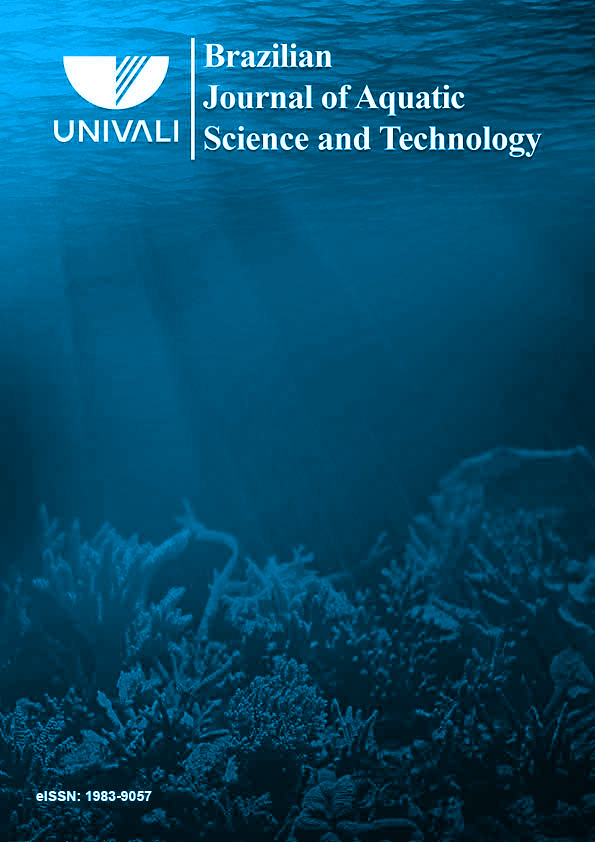

This study investigated the nitrogen and phosphorus uptake efficiency and recovery potential by the cosmopolitan macroalga Ulva fasciata. An equation to estimate biomass production, as well as nitrogen and phosphorus recovery, by Ulva species is further proposed. Results showed that U. fasciata removed 99% nitrogen (NH4+-NO3-) and 22% phosphate dissolved in water. Tissue nitrogen, phosphorus, and chlorophyll-a increased by 73 %, 20 %, and 244 %, respectively, demonstrating rapid assimilation of nutrients fueling U. fasciata growth (5.69 %.day-1). The constructed equation correlating fresh weight and area showed that 0.21 and 11.35 tons.ha-1.year-1 of phosphorus and nitrogen could be recovered and that 3.47 tons of dry biomass could be produced. Tissue data add to the understanding of the physiological effects of nutrient availability in U. fasciata. The efficient removal of dissolved nitrogen and phosphorus represents an important ecosystem service with potential for the production of value-added by-products.




Figueira, T. A.: da Silva, A. J. R.: Enrich-Prast, A.: Yoneshigue-Valentin, Y. & de Oliveira, V. P.
Structural characterization
of ulvanpolysaccharide from cultivated and collected Ulva fasciata (Chlorophyta). Adv Biosci Biotechnol. 11: 206-216.
García-Poza, S.; Morais, T.; Leandro, A.; Cotas, J.; Marques, J. C.; Pereira, L. & Gonçalves, A. M. M. A. 2022. Comparative study of the fatty acids and monosaccharides of wild and cultivated Ulva sp. J. Mar. Sci. Eng, 10: 233.
Grasshoff, K. & Johannsen, H. 1972. A new sensitive and direct method for the automatic determination of ammonia in sea water. ICES J. Mar. Sci. 34: 516–521.
Hernández, I.; Martínez-Aragón, J.; Tovar, A.; Pérez-Lloréns, J. and Vergara, J. 2002. Biofiltering efficiency in removal of dissolved nutrients by three species of estuarine macroalgae cultivated with sea bass (Dicentrarchus labrax) waste waters 2. ammonium. J. Appl. Phycol. 14: 375-384.
Koroleff, F. 1970. Direct determination of ammonia in natural waters as indophenols blue. Information on techniques and methods for seawater analysis, Charlottenlund, Internat. Counc. Exploration of the sea (Interlab. Rept. 3). pp. 19–22
Lavania-Baloo, A, S.; Said, M. I. M. & Ahmad, F. Mohamad, M. 2014. Biofiltration potential of macroalgae for ammonium removal in outdoor tank shrimp wastewater recirculation system. Biomass and Bioenergy. 66: 103-109.
Lee, T.-M.; Tsai, P.-F.; Shyu, Y.-T. & Sheu, F. 2005. The effects of phosphite on phosphate starvation responses of Ulva Lactuca (Ulvales, Chlorophyta). J. Phycol. 41: 975–982.
Lorenzen, C. J. 1967. Determination of chlorophyll and pheo-pigments: Spectrophotometric equations. Limnol. Oceanogr. 12: 343–346.
Lubsch, A. & Timmermans, K. 2018. Uptake kinetics and storage capacity of dissolved inorganic phosphorus and corresponding N: P dynamics in Ulva lactuca (Chlorophyta). J. Phycol. 54: 215-223.
Murphy, J. & Riley, J. 1962. A modified single solution method for the determination of phosphate in natural waters. Anal Chim Acta. 27: 31–36.
Nardelli, A. E.; Chiozzini, V. G.; Braga, E. S. & Chow, F. 2018. Integrated multi-trophic farming system between the green seaweed Ulva lactuca, mussel, and fish: a production and bioremediation solution. J. Appl. Phycol. 31: 847–856.
de Oliveira, V. P.; Martins, N. T.; Guedes, P. S.; Pollery, R. C. G. & Enrich-Prast, A. 2016 Bioremediation of nitrogenous compounds from oilfield wastewater by Ulva lactuca (Chlorophyta). Bioremed. J. 20:1–9.
Pedersen, M. F., & Borum, J. 1997. Nutrient control of estuarine macroalgae: growth strategy and the balance between nitrogen requirements and uptake. Mar. Ecol. Prog. Ser. 161: 155-163.
Reidenbach, L. B.; Fernandez, P. A.; Leal, P. P.; Noisette, F.; McGraw, C. M.; Revill, A. T.; Hurd, C. L. & Kübler, J. E. 2017. Growth, ammonium metabolism, and photosynthetic properties of Ulva australis (Chlorophyta) under decreasing pH and ammonium enrichment. PLoS ONE. 12 (e0188389).
Robertson-Andersson, D. V.; Potgieter, M.; Hansen, J.; Bolton, J. J.; Troell, M.; Anderson, R. J.; Halling, C. & Probyn, T. 2008. Integrated seaweed cultivation on an abalone farm in South Africa. J.Appl. Phycol. 20: 579–595. Shpigel, M.; Guttman, L.; Ben-Ezra, D.; Yu, J. & Chen, S. 2019. Is Ulva sp. able to be an efficient biofilter for mariculture effluents? J. Appl. Phycol. 31, 2449–2459.
Shpigel, M.; Guttman, L.; Ben-Ezra, D.; Yu, J. & Chen, S. 2019. Is ulva sp. able to be an efficient biofilter for mariculture effluents? J. Appl. Phycol. 31: 2449–2459.
Tremblay-Gratton, A.; Boussin, J.-C.; Tamigneaux, E.; Vandenberg, G. W. & Le François, N. R. 2017. Bioremediation efficiency of Palmaria palmata and Ulva lactuca for use in a fully recirculated cold-seawater naturalistic exhibit: effect of high NO3 and PO4 concentrations and temperature on growth and nutrient uptake. J. Appl. Phycol. 30: 1295–1304.
Ursi, S. and Plastino, E. M. 2001. Crescimento in vitro de linhagens de coloração vermelha e verde clara de Gracilaria birdiae (Gracilariales, Rhodophyta) em dois meios de cultura: análise de diferentes estágios reprodutivos. Rev. Bras. Bot. 24: 587-594.
Zollmann, M.; Rubinsky, B.; Liberzon, A. & Golberg A. 2021. Multi-scale modeling of intensive macroalgae cultivation and marine nitrogen sequestration. Commun. Biol. 4:848.






Ciências Ambientais, Ambientes Aquáticos e Costeiros.
BJAST adota a política de publicação contínua de artigos. Assim, sempre que um manuscrito for aprovado para publicação, estará imediatamente disponível para leitura.

